ssd原理及代码实现详解
- 2019 年 10 月 29 日
- 笔记
通过https://github.com/amdegroot/ssd.pytorch,结合论文https://arxiv.org/abs/1512.02325来理解ssd.
ssd由三部分组成:
- base
- extra
- predict
base原论文里用的是vgg16去掉全连接层.

base + extra完成特征提取的功能.得到不同size的feature map,基于这些feature maps,我们再用不同的卷积核去卷积,分别完成类别预测和坐标预测.
基础特征提取网络
特征提取网络由两部分组成
- vgg16
- extra layer
vgg16变种
vgg16结构:

将vgg16的全连接层用卷积层换掉.
代码实现
ssd.py中
base = { '300': [64, 64, 'M', 128, 128, 'M', 256, 256, 256, 'C', 512, 512, 512, 'M', 512, 512, 512], '512': [], } extras = { '300': [256, 'S', 512, 128, 'S', 256, 128, 256, 128, 256], '512': [], } }定义了每一层的卷积核的数量.其中’M’,’C’均代表maxpool池化层.只是’C’会使用 ceil instead of floor to compute the output shape.
参见https://pytorch.org/docs/stable/nn.html#maxpool2d
def vgg(cfg, i, batch_norm=False): layers = [] in_channels = i for v in cfg: if v == 'M': layers += [nn.MaxPool2d(kernel_size=2, stride=2)] elif v == 'C': layers += [nn.MaxPool2d(kernel_size=2, stride=2, ceil_mode=True)] else: conv2d = nn.Conv2d(in_channels, v, kernel_size=3, padding=1) if batch_norm: layers += [conv2d, nn.BatchNorm2d(v), nn.ReLU(inplace=True)] else: layers += [conv2d, nn.ReLU(inplace=True)] in_channels = v pool5 = nn.MaxPool2d(kernel_size=3, stride=1, padding=1) conv6 = nn.Conv2d(512, 1024, kernel_size=3, padding=6, dilation=6) conv7 = nn.Conv2d(1024, 1024, kernel_size=1) layers += [pool5, conv6, nn.ReLU(inplace=True), conv7, nn.ReLU(inplace=True)] return layers 这样就形成了一个基础的特征提取网络.前面的部分和vgg16一样的,全连接层换成了conv6+relu+conv7+relu.
extra layer
在前面得到的输出的基础上,继续做卷积,以得到更多不同尺寸的feature map.
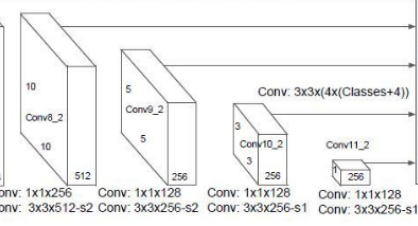
代码实现
extras = { '300': [256, 'S', 512, 128, 'S', 256, 128, 256, 128, 256], '512': [], } def add_extras(cfg, i, batch_norm=False): # Extra layers added to VGG for feature scaling layers = [] in_channels = i flag = False for k, v in enumerate(cfg): if in_channels != 'S': if v == 'S': layers += [nn.Conv2d(in_channels, cfg[k + 1], kernel_size=(1, 3)[flag], stride=2, padding=1)] else: layers += [nn.Conv2d(in_channels, v, kernel_size=(1, 3)[flag])] flag = not flag in_channels = v return layers add_extras(extras[str(size)], 1024)[256, ‘S’, 512, 128, ‘S’, 256, 128, 256, 128, 256]用以创建layer.
如果是’S’的话,代表用的卷积核为3 x 3,否则为1 x 1,卷积核的数量为’S’下一个的数字.
这样的话,我们就构建出了extra layers.
多尺度检测multibox
我们已经得到了很多layer的输出(称其为feature map).size有大有小. 那么现在我们就对某些层(conv4_3,conv7,conv8_2,conv9_2,conv10_2,conv11_2)的feature map再做卷积,得到类别和位置信息.
分别用2组3 x 3的卷积核去做卷积,一个负责预测类别,一个负责预测位置.卷积核的个数分别为boxnum x clasess_num,boxnum x 4(坐标由4个参数,中心坐标,box宽高即可确定).
即在m x m的feature map上做卷积我们会得到一个m x m x (boxnum x clasess_num) 和一个m x m x (boxnum x 4)的tensor.分别用以计算概率和框的位置.
代码实现
def multibox(vgg, extra_layers, cfg, num_classes): loc_layers = [] conf_layers = [] vgg_source = [21, -2] for k, v in enumerate(vgg_source): loc_layers += [nn.Conv2d(vgg[v].out_channels, cfg[k] * 4, kernel_size=3, padding=1)] conf_layers += [nn.Conv2d(vgg[v].out_channels, cfg[k] * num_classes, kernel_size=3, padding=1)] for k, v in enumerate(extra_layers[1::2], 2): loc_layers += [nn.Conv2d(v.out_channels, cfg[k] * 4, kernel_size=3, padding=1)] conf_layers += [nn.Conv2d(v.out_channels, cfg[k] * num_classes, kernel_size=3, padding=1)] return vgg, extra_layers, (loc_layers, conf_layers)其中每一个feature map预测几个box由下面变量给出.
mbox = { '300': [4, 6, 6, 6, 4, 4], # number of boxes per feature map location '512': [], }在哪些layer的feature map上做预测,根据论文里是固定的,参见开头的ssd结构图.反映到代码里则为
vgg_source = [21, -2] extra_layers[1::2]即
中的conv4_3,conv7,conv8_2,conv9_2,conv10_2,conv11_2这六个layer的feature map.
先验框生成
你可以称之为priorbox/default box/anchor box都是一个意思.
我们先来讲先验框的原理.这个其实类似yolov3中的anchor box,我们基于这些shape的box去做预测.
priorbox和不同的feature map上做预测都是为了解决对不同尺寸的物体的检测问题.不同的feature map负责不同尺寸的目标.同时每一个feature map cell又负责该尺寸的不同宽高比的目标.
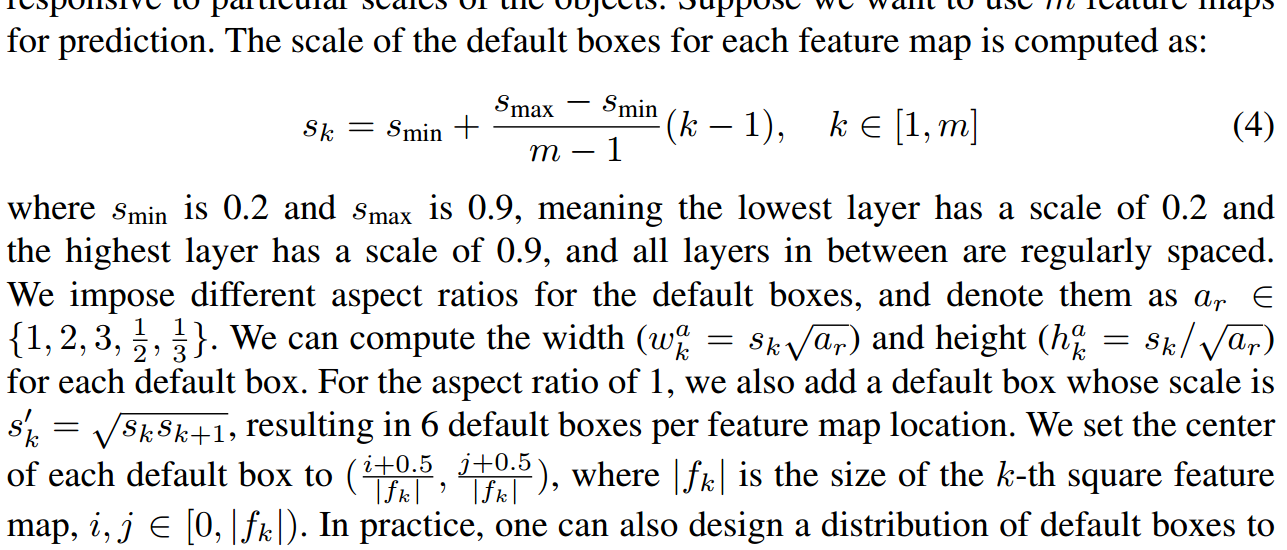
首先,不同的feature_map负责不同的尺寸.
[s_k = s_{min} + frac{s_{max} – s_{min}}{m-1}(k-1), kin [1,m]]
对smin=0.2,smax=0.9.m=6(我们在6个layer的feature map上做检测), 因此就有 s={0.2,0.34,0.48,0.62,0.76,0.9}.
假设宽高比分别为(a_r ={1,2,3,1/2,1/3}),则对第二个feature map(19 x 19的这个,conv7),那么[w_k^a = s_ksqrt{a_r},h_k^a = s_k/sqrt{a_r}],我们计算宽高比为1的box,则得到的box为(0.2,0.2).模型的输入图像尺寸是(300,300),那么相应的box为(60,60).依次类推,可以得到其余的deafult box的shape共6个.(对宽高比为1的box,额外多计算一个(s_k^prime)的box出来). 从而我们得到了这一个feature map负责预测的不同形状的box
如图:
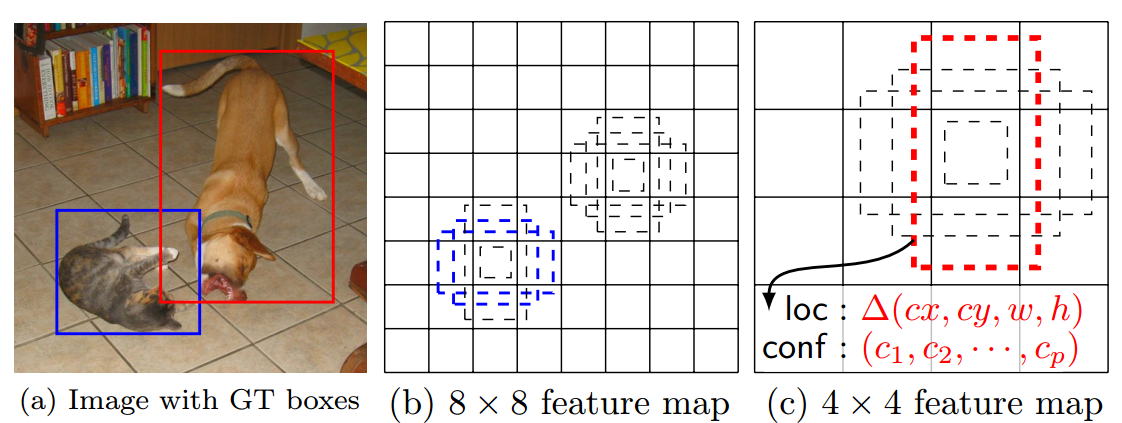
那么对于conv4_3这个layer而言的话,我们设定的deafault box数量是4,于是我们最终就有38 x 38 x 4个box.我们在这些box的基础上去预测我们的box.
我们对不同层的default box的数量设定是(4, 6, 6, 6, 4, 4),所以我们最终总共预测出(38^2 times 4+19^2 times 6+ 10^2 times 6+5^2 times 6+3^2 times 4+1^2 times 4 = 8732)个box.
那实际调参的重点也就是这些default box的调整,要尽量使其贴合你自己要检测的目标.,类似于yolov3中调参调整anchor的大小.
代码实现
prior_box.py中定义了PriorBox类,forward函数实现default box的计算.
配置文件定义域config.py
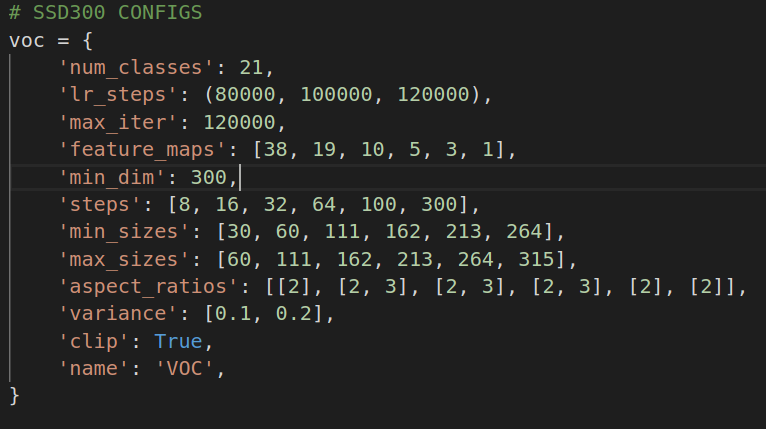
其中
'min_sizes': [30, 60, 111, 162, 213, 264], 'max_sizes': [60, 111, 162, 213, 264, 315], 'aspect_ratios': [[2], [2, 3], [2, 3], [2, 3], [2], [2]],用以计算每一个feature map的default box. 这里配置文件的定义让人稍微有点糊涂. min_size/max_size都是用于宽高比为1的box的预测.[2]用于预测宽高比为2:1和1:2的box.
def forward(self): mean = [] for k, f in enumerate(self.feature_maps): #config.py中'feature_maps': [38, 19, 10, 5, 3, 1] for i, j in product(range(f), repeat=2): f_k = self.image_size / self.steps[k] #基本上除下来和feature_map size类似. 这里直接用f替代f_k区别不大 # unit center x,y # 每个feature_map cell的中心 cx = (j + 0.5) / f_k cy = (i + 0.5) / f_k # aspect_ratio: 1 # rel size: min_size s_k = self.min_sizes[k]/self.image_size #min_sizes预测一个宽高比为1的shape mean += [cx, cy, s_k, s_k] # aspect_ratio: 1 # rel size: sqrt(s_k * s_(k+1)) s_k_prime = sqrt(s_k * (self.max_sizes[k]/self.image_size)) #max_size负责预测一个宽高比为1的shape mean += [cx, cy, s_k_prime, s_k_prime] # rest of aspect ratios # for ar in self.aspect_ratios[k]: #比如对[2,3]则预测4个shape,1;2,2:1,1:3,3:1 mean += [cx, cy, s_k*sqrt(ar), s_k/sqrt(ar)] mean += [cx, cy, s_k/sqrt(ar), s_k*sqrt(ar)]比如对38 x 38这个feature map的第一个cell,共计算出4个default box.前两个参数是box中点,后面是宽,高.都是相对原图的比例.
tensor([[0.0133, 0.0133, 0.1000, 0.1000], [0.0133, 0.0133, 0.1414, 0.1414], [0.0133, 0.0133, 0.1414, 0.0707], [0.0133, 0.0133, 0.0707, 0.1414]])预测框生成
feature_map卷积后的tensor含义
每一个feature_map卷积后可得一个m x m x 4的tensor.其中4是(t_x,t_y,t_w,t_h),这时候我们需要用这些数在default box的基础上去得到我们的预测框的坐标.可以认为神经网络预测得到的是相对参考框的偏移. 这也是所谓的把坐标预测当做回归问题的含义.box=anchor_box x 形变矩阵,我们回归的就是这个形变矩阵的参数,即(t_x,t_y,t_w,t_h)
即
b_center_x = t_x *prior_variance[0]* p_width + p_center_x b_center_y = t_y *prior_variance[1] * p_height + p_center_y b_width = exp(prior_variance[2] * t_w) * p_width b_height = exp(prior_variance[3] * t_h) * p_height 或者 b_center_x = t_x * p_width + p_center_x b_center_y = t_y * p_height + p_center_y b_width = exp(t_w) * p_width b_height = exp(t_h) * p_height 其中p_*代表的是default box. b_*才是我们最终预测的box的坐标.
这时候我们得到了很多很多(8732)个box.我们要从这些box中筛选出我们最终给出的box.
伪代码为
for every conv box: for every class : if class_prob < theshold: continue predict_box = decode(convbox) nms(predict_box) #去除非常接近的框代码实现
detection.py
class Detect(Function): def forward(self, loc_data, conf_data, prior_data): ##loc_data [batch,8732,4] ##conf_data [batch,8732,1+class] ##prior_data [8732,4] num = loc_data.size(0) # batch size num_priors = prior_data.size(0) output = torch.zeros(num, self.num_classes, self.top_k, 5) conf_preds = conf_data.view(num, num_priors, self.num_classes).transpose(2, 1) # Decode predictions into bboxes. for i in range(num): decoded_boxes = decode(loc_data[i], prior_data, self.variance) # For each class, perform nms conf_scores = conf_preds[i].clone() for cl in range(1, self.num_classes): c_mask = conf_scores[cl].gt(self.conf_thresh) scores = conf_scores[cl][c_mask] if scores.size(0) == 0: continue l_mask = c_mask.unsqueeze(1).expand_as(decoded_boxes) boxes = decoded_boxes[l_mask].view(-1, 4) # idx of highest scoring and non-overlapping boxes per class ids, count = nms(boxes, scores, self.nms_thresh, self.top_k) output[i, cl, :count] = torch.cat((scores[ids[:count]].unsqueeze(1), boxes[ids[:count]]), 1) flt = output.contiguous().view(num, -1, 5) _, idx = flt[:, :, 0].sort(1, descending=True) _, rank = idx.sort(1) flt[(rank < self.top_k).unsqueeze(-1).expand_as(flt)].fill_(0) return output 具体的核心逻辑在box_utils.py
- decode 用于根据卷积结果计算box坐标
def decode(loc, priors, variances): boxes = torch.cat(( priors[:, :2] + loc[:, :2] * variances[0] * priors[:, 2:], priors[:, 2:] * torch.exp(loc[:, 2:] * variances[1])), 1) boxes[:, :2] -= boxes[:, 2:] / 2 boxes[:, 2:] += boxes[:, :2] return boxes这里做了一个center_x,center_y, w, h -> xmin, ymin, xmax, ymax的转换.
boxes[:, :2] -= boxes[:, 2:] / 2 boxes[:, 2:] += boxes[:, :2]返回的已经是(xmin, ymin, xmax, ymax)的形式来表示box了.
- nms 如果两个框的overlap超过0.5,则认为框的是同一个物体,只保留概率更高的框
def nms(boxes, scores, overlap=0.5, top_k=200): """Apply non-maximum suppression at test time to avoid detecting too many overlapping bounding boxes for a given object. Args: boxes: (tensor) The location preds for the img, Shape: [num_priors,4]. scores: (tensor) The class predscores for the img, Shape:[num_priors]. overlap: (float) The overlap thresh for suppressing unnecessary boxes. top_k: (int) The Maximum number of box preds to consider. Return: The indices of the kept boxes with respect to num_priors. """ keep = scores.new(scores.size(0)).zero_().long() if boxes.numel() == 0: return keep x1 = boxes[:, 0] y1 = boxes[:, 1] x2 = boxes[:, 2] y2 = boxes[:, 3] area = torch.mul(x2 - x1, y2 - y1) v, idx = scores.sort(0) # sort in ascending order # I = I[v >= 0.01] idx = idx[-top_k:] # indices of the top-k largest vals xx1 = boxes.new() yy1 = boxes.new() xx2 = boxes.new() yy2 = boxes.new() w = boxes.new() h = boxes.new() # keep = torch.Tensor() count = 0 while idx.numel() > 0: i = idx[-1] # index of current largest val # keep.append(i) keep[count] = i count += 1 if idx.size(0) == 1: break idx = idx[:-1] # remove kept element from view # load bboxes of next highest vals torch.index_select(x1, 0, idx, out=xx1) torch.index_select(y1, 0, idx, out=yy1) torch.index_select(x2, 0, idx, out=xx2) torch.index_select(y2, 0, idx, out=yy2) # store element-wise max with next highest score xx1 = torch.clamp(xx1, min=x1[i]) yy1 = torch.clamp(yy1, min=y1[i]) xx2 = torch.clamp(xx2, max=x2[i]) yy2 = torch.clamp(yy2, max=y2[i]) w.resize_as_(xx2) h.resize_as_(yy2) w = xx2 - xx1 h = yy2 - yy1 # check sizes of xx1 and xx2.. after each iteration w = torch.clamp(w, min=0.0) h = torch.clamp(h, min=0.0) inter = w*h # IoU = i / (area(a) + area(b) - i) rem_areas = torch.index_select(area, 0, idx) # load remaining areas) union = (rem_areas - inter) + area[i] IoU = inter/union # store result in iou # keep only elements with an IoU <= overlap idx = idx[IoU.le(overlap)] return keep, count
以上就是有关ssd网络结构以及每一层的输出的含义.这些已经足够我们了解推理过程了.即给定一个图,模型如何预测出box的位置.后面我们将继续关注训练的过程.
loss计算
第一个要解决的问题就是box匹配的问题.即每一次训练,怎样的预测框算是预测对了?我们需要计算这些模型认为的预测对了的box和真正的ground truth box之间的差异.
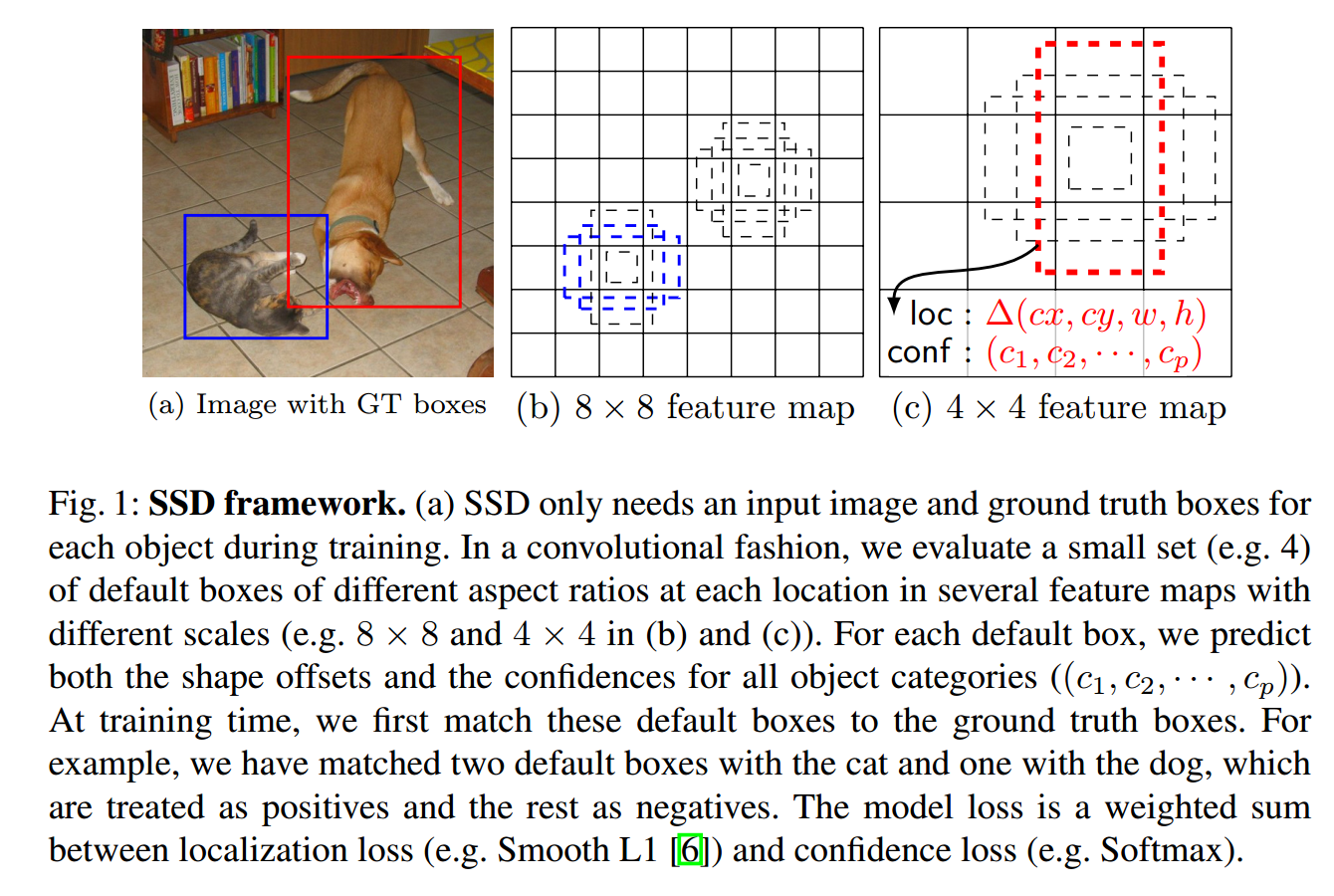
如上所示,猫的ground truth box匹配了2个default box,狗的ground truth box匹配了1个default box.
匹配策略

匹配策略是
- 把gt box朝着prior box做匹配,和gt box的IOU最高的prior box被选为正样本
- 任意和gt box的IOU大于0.5的也被选为正样本
有一个问题困扰了我好久,第二步不是包含第一步吗,直到某天豁然开朗,可能所有的prior box与gt box的iou都<阈值,第一步就是为了保证至少有一个prior box与gt box对应
box_utils.py
def match(threshold, truths, priors, variances, labels, loc_t, conf_t, idx): # jaccard index #[objects_num,priorbox_num] overlaps = jaccard( truths, point_form(priors) ) # (Bipartite Matching) # [num_objects,1] best prior for each ground truth best_prior_overlap, best_prior_idx = overlaps.max(1, keepdim=True) #返回每行的最大值,即哪个priorbox与当前obj gt box的IOU最大 # [1,num_priors] best ground truth for each prior best_truth_overlap, best_truth_idx = overlaps.max(0, keepdim=True) #返回每列的最大值,即哪个obj gt box与当前prior box的IOU最大 best_truth_idx.squeeze_(0) #best_truth_idx的shape是[1,num_priors],去掉第0维度将shape变为[num_priors] best_truth_overlap.squeeze_(0) #同上 best_prior_idx.squeeze_(1) #best_prior_idx的shape是[num_objects,1],去掉第一维度变为[num_objects] best_prior_overlap.squeeze_(1) best_truth_overlap.index_fill_(0, best_prior_idx, 2) # ensure best prior #把best_truth_overlap第0维度best_prior_idx位置的值的替换为2,以使其肯定>theshold # TODO refactor: index best_prior_idx with long tensor # ensure every gt matches with its prior of max overlap for j in range(best_prior_idx.size(0)): best_truth_idx[best_prior_idx[j]] = j matches = truths[best_truth_idx] # Shape: [num_priors,4] conf = labels[best_truth_idx] + 1 # Shape: [num_priors] conf[best_truth_overlap < threshold] = 0 # label as background loc = encode(matches, priors, variances) loc_t[idx] = loc # [num_priors,4] encoded offsets to learn conf_t[idx] = conf # [num_priors] top class label for each prior 这里的逻辑实际上是有点绕的.给个具体的例子会更好滴帮助你理解.
我们假设一张图片里有2个object.那就有2个gt box,假设计算出3个(实际是8732个)prior box.计算每个gt box和每个prior box的iou即得到一个两行三列的overlaps.
import torch #假设一幅图里有2个obj,预测出3个box,其iou如overlaps所示 truths = torch.Tensor([[1,2,3,4],[5,6,7,8]]) #2个gtbox 每个box坐标由四个值确定 labels = torch.Tensor([[5],[6]])#2个obj分别属于类别5,类别6 overlaps = torch.Tensor([[0.1,0.4,0.3],[0.5,0.2,0.6]]) #overlaps = torch.Tensor([[0.9,0.9,0.9],[0.8,0.8,0.8]]) best_prior_overlap, best_prior_idx = overlaps.max(1, keepdim=True) #[2,1] #print(best_prior_overlap) #print(best_prior_idx) #与目标gt box iou最大的prior box 下标 best_truth_overlap, best_truth_idx = overlaps.max(0, keepdim=True) #返回每列的最大值,即哪个obj gt box与当前prior box的IOU最大 #print(best_truth_overlap) #[1,3] #print(best_truth_idx) #与prior box iou最大的gt box 下标 best_truth_idx.squeeze_(0) #best_truth_idx的shape是[1,num_priors],去掉第0维度将shape变为[num_priors] best_truth_overlap.squeeze_(0) #同上 best_prior_idx.squeeze_(1) #best_prior_idx的shape是[num_objects,1],去掉第一维度变为[num_objects] best_prior_overlap.squeeze_(1) print(best_prior_idx) print(best_truth_idx) #把和gt box的iou最大的prior box的iou设置为2(只要大于阈值就可以了),以确保这个prior box一定会被保留下来. best_truth_overlap.index_fill_(0, best_prior_idx, 2) #比如所有的prior box都和gt box1的iou=0.9,prior box2和gt box2的iou=0.8. 我们要确保prior box2被匹配到gt box2而不是gt box1. #把overlaps = torch.Tensor([[0.9,0.9,0.9],[0.8,0.8,0.8]])试试就知道了 for j in range(best_prior_idx.size(0)): print(j) best_truth_idx[best_prior_idx[j]] = j print(best_truth_idx) matches = truths[best_truth_idx] #[3,4] 列代表每一个对应的gt box的坐标 print(matches) print(best_truth_overlap) conf = labels[best_truth_idx] + 1 #[3,1]每一列代表当前prior box对应的gt box的类别 print(conf.shape) #conf[best_truth_overlap < threshold] = 0 #过滤掉iou太低的,标记为background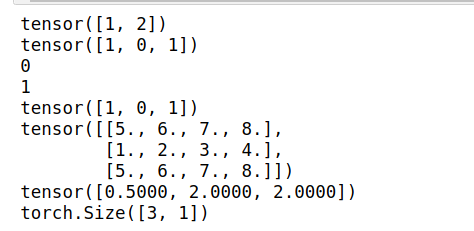
至此,我们得到了matches,即对每一个prior box都找到了其对应的gt box.也得到了conf.即prior box归属的类别.如果iou过低的,类别就被标记为background.
接下来
def encode(matched, priors, variances): # dist b/t match center and prior's center g_cxcy = (matched[:, :2] + matched[:, 2:])/2 - priors[:, :2] # encode variance g_cxcy /= (variances[0] * priors[:, 2:]) # match wh / prior wh g_wh = (matched[:, 2:] - matched[:, :2]) / priors[:, 2:] g_wh = torch.log(g_wh) / variances[1] # return target for smooth_l1_loss return torch.cat([g_cxcy, g_wh], 1) # [num_priors,4] 我们比较prior box和其对应的gt box的差异.注意这里的matched的格式是(lefttop_x,lefttop_y,rightbottom_x,rightbottom_y).
所以这里得到的其实是gt box和prior box之间的偏移.
计算loss
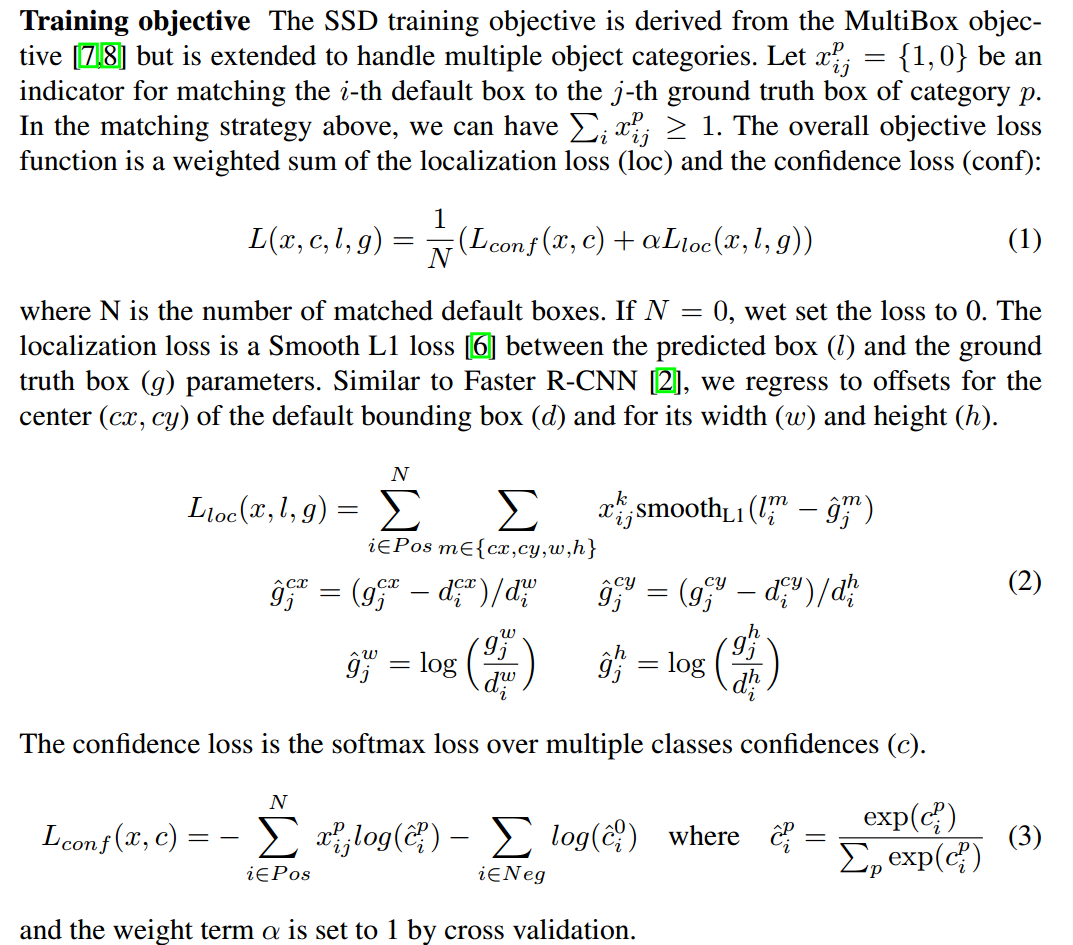
对于所有的prior box而言,一共可以分为三种类型
- 正样本
- loss排名靠前的xx个负样本
- 其余负样本
其中正样本即:与ground truth box的iou超过阈值或者iou最大的prior box.
负样本:正样本之外的prior box.
损失函数分为2部分,一部分是坐标偏移的损失,一部分是类别信息的损失.
在计算loc损失的时候,只考虑正样本. 在计算conf损失的时候,即考虑正样本又考虑负样本.并且保持负样本:正样本=3:1.
代码实现在:
multibox_loss.py
class MultiBoxLoss(nn.Module): def forward(self, predictions, targets): 伪代码可以表述为
#根据匹配策略得到每个prior box对应的gt box #根据iou筛选出positive prior box #计算conf loss #筛选出loss靠前的xx个negative prior box.保证neg:pos=3:1 #计算交叉熵 #归一化处理- 坐标偏移的loss
pos_idx = pos.unsqueeze(pos.dim()).expand_as(loc_data) loc_p = loc_data[pos_idx].view(-1, 4) #预测得到的偏移量 loc_t = loc_t[pos_idx].view(-1, 4) #真实的偏移量 loss_l = F.smooth_l1_loss(loc_p, loc_t, size_average=False) #我们回归的就是相对default box的偏移用smooth_l1_loss. 代码比较简单,不多讲了.
Hard negative mining
在匹配default box和gt box以后,必然是有大量的default box是没有匹配上的.即只有少量正样本,有大量负样本.对每个default box,我们按照confidence loss从高到低排序.我们只取排在前列的一些default box去计算loss,使得负样本:正样本在3:1. 这样可以使得模型更加快地优化,训练更稳定.
关于目标检测中的样本不平衡可以参考https://zhuanlan.zhihu.com/p/60612064
简单滴说就是,负样本使得我们学到背景信息,正样本使得我们学到目标信息.所以二者都需要,并且保持一个合适比例.论文里用的是3:1.
对应代码即MultiBoxLoss.negpos_ratio
# Compute max conf across batch for hard negative mining batch_conf = conf_data.view(-1, self.num_classes) #[batch*8732,21] loss_c = log_sum_exp(batch_conf) - batch_conf.gather(1, conf_t.view(-1, 1)) #conf_t的列方向是类别信息 # Hard Negative Mining loss_c[pos] = 0 # filter out pos boxes for now loss_c = loss_c.view(num, -1) _, loss_idx = loss_c.sort(1, descending=True) _, idx_rank = loss_idx.sort(1) num_pos = pos.long().sum(1, keepdim=True) num_neg = torch.clamp(self.negpos_ratio*num_pos, max=pos.size(1)-1) #得到负样本的index neg = idx_rank < num_neg.expand_as(idx_rank)这时候的loss还不是网络的conf loss,并不是论文里的l_conf.
def log_sum_exp(x): """Utility function for computing log_sum_exp while determining This will be used to determine unaveraged confidence loss across all examples in a batch. Args: x (Variable(tensor)): conf_preds from conf layers """ x_max = x.data.max() return torch.log(torch.sum(torch.exp(x-x_max), 1, keepdim=True)) + x_max这里用到了一个trick.参考https://github.com/amdegroot/ssd.pytorch/issues/203,https://stackoverflow.com/questions/42599498/numercially-stable-softmax
为了避免e的n次幂太大或者太小而无法计算,常常在计算softmax时使用这个trick.
这个函数严重影响了我对loss_c的理解,实际上,你可以把上述函数中的x_max移除.那这个函数
那么loss_c就变为了
loss_c = torch.log(torch.sum(torch.exp(batch_conf), 1, keepdim=True)) - batch_conf.gather(1, conf_t.view(-1, 1))就好理解多了.
conf_t的列方向是相应的label的index. batch_conf.gather(1, conf_t.view(-1, 1))得到一个[batch*8732,1]的tensor,即只保留prior box对应的label的概率预测信息.
那总体的loss即为所有类别的loss之和减去这个prior box应该负责的label的loss.
得到loss_c以后,我们去得到正样本/负样本的index
# 选出loss最大的一些负样本 负样本:正样本=3:1 # Hard Negative Mining loss_c = loss_c.view(num, -1) #[batch,8732] loss_c[pos] = 0 # filter out pos boxes for now _, loss_idx = loss_c.sort(1, descending=True) #对每张图的priorbox的conf loss逆序排序 print(_[0,:],loss_idx[0]) #[batch,8732] 每一列的值为prior box的index _, idx_rank = loss_idx.sort(1) print(_[0,:],idx_rank[0,:]) #[batch,8732] 每一列的值为prior box在loss_idx的位置.我们要选取前loss_idx中的前xx个.(xx=3倍负样本) num_pos = pos.long().sum(1, keepdim=True) print(num_pos) #[batch,1] 列的值为每张图的正样本数量 #求得负样本的数量,3倍正样本,如果3倍正样本>全部prior box,则设置负样本数量为prior box数量 num_neg = torch.clamp(self.negpos_ratio*num_pos, max=pos.size(1)-1) print(num_neg) #选出loss排名最靠前的num_neg个负样本 neg = idx_rank < num_neg.expand_as(idx_rank) print(neg) 至此,我们就得到了正负样本的下标.接下来就可以计算预测值与真值的差异了.
loss_c = F.cross_entropy(conf_p, targets_weighted, size_average=False) # Sum of losses: L(x,c,l,g) = (Lconf(x, c) + αLloc(x,l,g)) / N N = num_pos.data.sum() loss_l /= N loss_c /= N return loss_l, loss_c 用交叉熵衡量loss. 最后除以正样本的数量,做归一化处理.
https://pytorch.org/docs/stable/nn.html#torch.nn.CrossEntropyLoss

在计算loss前,不需要手动softmax转换成概率值了.
训练
前面已经实现了网络结构创建,loss计算.接下来就可以实现训练了.
实现在train.py
精简后的主要逻辑如下:
ssd_net = build_ssd('train', cfg['min_dim'], cfg['num_classes']) net = ssd_net optimizer = optim.SGD(net.parameters(), lr=args.lr, momentum=args.momentum, weight_decay=args.weight_decay) criterion = MultiBoxLoss(cfg['num_classes'], 0.5, True, 0, True, 3, 0.5, False, args.cuda) for iteration in range(args.start_iter, cfg['max_iter']): # load train data images, targets = next(batch_iterator) # forward out = net(images) # backprop optimizer.zero_grad() loss_l, loss_c = criterion(out, targets) loss = loss_l + loss_c loss.backward() optimizer.step() 即
- 定义网络结构
- 定义损失函数及反向传播求梯度方法
- 加载训练集
- 前向传播得到预测值
- 计算loss
- 反向传播,更新网络权重参数
涉及到的部分torch中函数用法参考:https://www.cnblogs.com/sdu20112013/p/11731741.html


